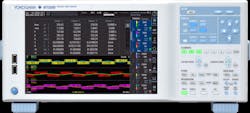The expansion of applications requiring some kind of motion functionality has increased the use of variable-speed drives in electronic systems. Variable-speed drives offer substantial power savings, and motor-drive manufacturers are improving performance by increasing the switching capabilities of the circuit. This enables the use of smaller capacitors and magnetic components, saving space as well as weight.
German automation and motion-control specialist KEB Automation’s latest challenge is to meet tough new EU Ecodesign Directive requirements governing the energy efficiency of drives and automation equipment. Faster switching makes it harder to obtain accurate measurements of key parameters due to the higher level of common-mode noise. The company decided on the Yokogawa WT5000 precision power analyzer to develop its latest generation of frequency converters for variable-speed drives to ensure that they meet updated EU energy-efficiency regulations.
David Kater, development engineer at KEB, says, “Fast-switching semiconductors generate common-mode voltages at high frequencies, inducing parasitic common-mode currents even in small capacitances. We only want to see the differential mode in the measurement, which is why common-mode rejection is extremely important.”
KEB uses power analyzers in the development of the design for final validation of the design’s performance, as well as to characterize production units. Regarding the Yokogawa WT5000, analysis of its performance showed KEB engineers that the currents due to common-mode noise were extremely low. In its tests of the WT5000, KEB found no significant crosstalk from channels affected by common-mode noise to other channels.
The system’s full measurement bandwidth is 5 MHz for current and 10 MHz for voltage; power measurements are accurate to 0.01% (reading) and 0.02% (range) at ac mains frequency (50/60 Hz). Other major benefits include a guaranteed accuracy of ±0.03%, the ability to conduct harmonic comparisons up to the 500th order, and custom computation facilities. Additional features include seven slots for user-swappable input elements, as well as a number of mainframe options.
The system can evaluate up to four motors simultaneously while allowing the instrument to be expanded or reconfigured. It can stream its raw captured data to a PC for detailed analysis. The WT5000 provides a full touchscreen, supported by hardware hotkeys and software for remote measurements. It can immediately recognize the module configuration after switching on, followed by automatic initialization of the channels.
Related links:

